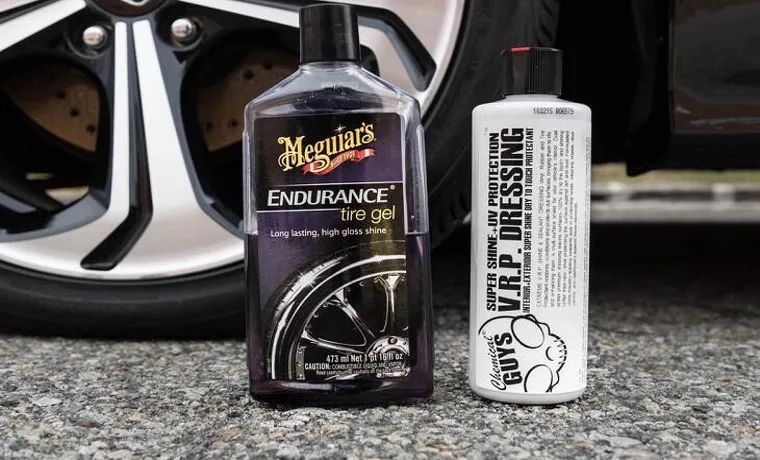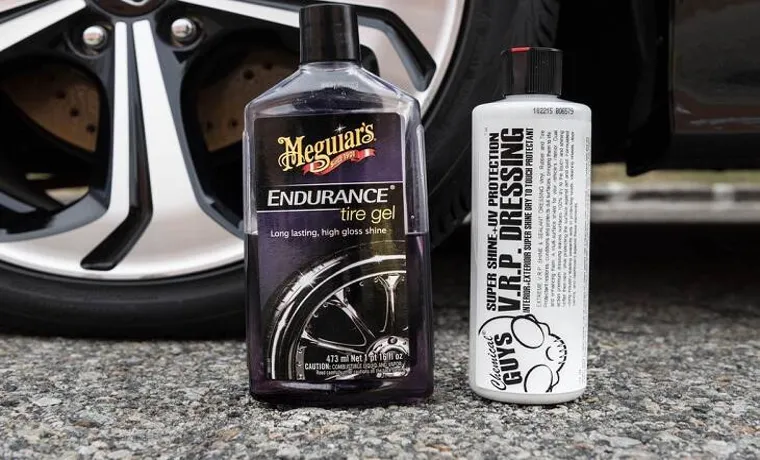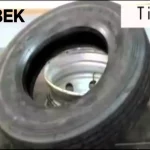Tire blooming is a common phenomenon that can be observed on car tires. It occurs when the rubber compound used in tires reacts to various environmental factors, such as heat and humidity. Over time, this can cause your tires to look dirty and aged, which can be difficult to remove.
Fortunately, there is a simple solution to this problem. In this blog post, we will tell you how to remove tire blooming and keep your car’s tires looking great. So, whether you are a car enthusiast or just want your vehicle to look its best, keep reading to find out how easy it is to keep your tires looking brand new!
Table of Contents
Understanding Tire Blooming
If you’re a car enthusiast, you’ve probably heard the term “tire blooming” thrown around. But what exactly is it, and how do you remove it? Tire blooming refers to the white residue that appears on the surface of tires after being parked for a long time. It’s caused by the release of silicon dioxide and other chemicals as the tire compounds break down.
While it’s unsightly, tire blooming won’t affect the tire’s performance or durability. To remove it, you can either use a specially formulated tire cleaner or a mix of baking soda and water. Simply apply the cleaner to the affected area and scrub with a soft brush or cloth until the blooming disappears.
Alternatively, mix baking soda and water to create a paste and apply it to the tire. Let it sit for a few minutes before scrubbing with a brush or cloth. Once finished, rinse with water and dry the tire completely.
Now you can enjoy a clean and polished set of wheels on your car.
What Causes Tire Blooming?
Tire blooming refers to the appearance of brown or white discoloration on the sidewall of tires. The main cause of tire blooming is the hardening of the tire’s surface due to exposure to UV rays and other environmental elements. The phenomenon is more common in tires made from natural rubber but can also occur in synthetic rubbers.
The blooming appears when the oils and waxes that are used to make the tread supple rise to the surface and evaporate, leaving behind a dry and hardened rubber surface. Tire blooming is not harmful to the tire’s performance; it’s merely a cosmetic issue that can affect the appearance of your vehicle. Regular cleaning and application of a tire protectant or tire dressing can help prevent the occurrence of tire blooming, prolong the life of the tire, and improve their overall appearance.

Signs and Symptoms of Tire Blooming
Tire blooming is a common phenomenon that affects rubber compounds in tires, leading to a change in appearance and performance. The term refers to a visible discoloration or whitening of the sidewall or tread area of a tire, caused by the migration of oils and other compounds to the surface of the rubber. This can occur due to a variety of factors, such as exposure to heat, UV light, ozone, and chemicals.
Tire blooming can also affect the elasticity and durability of the tire, making it more prone to cracking, splitting, or loss of grip. Therefore, it is crucial to recognize the signs and symptoms of tire blooming, such as a cloudy or hazy appearance, a powdery or sticky texture, or a loss of gloss or sheen. If you notice any of these symptoms, it is recommended to have your tires inspected by a professional and to take appropriate measures to prevent further damage.
Regular cleaning, conditioning, and storage in a cool, dry, and dark place can help mitigate the effects of tire blooming and prolong the life of your tires.
Preventing Tire Blooming
Tire blooming, also known as rubber blooming, is a common issue that many car owners face. It occurs when the tire’s surface becomes dull, faded, or even whitish due to the migration of rubber compounds to the surface. This phenomenon can cause your tires to look unsightly and can sometimes indicate a reduction in their performance, such as reduced traction.
To prevent tire blooming, you should clean your tires regularly using a mild detergent or soap and water. You can also use tire shine products that contain silicone to protect the rubber surface from ultraviolet (UV) rays that can catalyst blooming. Additionally, storing your vehicle in a cool and dry place can significantly help prevent tire blooming.
Keeping your tires in good condition is vital not only for aesthetic purposes but also for your safety and your vehicle’s overall performance. Therefore, make sure to address any blooming issues promptly and take the necessary precautions to prevent it from happening again.
Proper Storage and Inflation
Proper storage and inflation of tires can prevent tire blooming, which is a common problem among vehicle owners. Blooming occurs when a tire’s surface turns brown due to prolonged exposure to sunlight and other environmental factors. To prevent blooming, it is essential to store tires in a cool, dry place away from direct sunlight.
In addition, proper inflation is crucial. Over-inflated tires can cause excessive heat buildup, leading to blooming, while under-inflated tires cause excessive flexing, leading to uneven wear and tear. Ensuring your vehicle’s tires are properly inflated and stored is critical in preventing unnecessary wear and tear, prolonging the life of your tires, and keeping you safe while on the road.
Choosing the Right Cleaning Products
Choosing the right cleaning products is crucial in maintaining your vehicle’s appearance and longevity. It’s essential to avoid harsh chemicals or abrasive materials that can damage the car’s paint and finish. One common issue people face is tire blooming, where the tires turn brown due to wax, grease, or dirt buildup.
To prevent this, avoid using silicone-based tire shines and instead opt for water-based alternatives. Additionally, regular washing and drying of the tires can remove any excess grime and prevent buildup. By choosing the right cleaning products and regularly maintaining your vehicle, you can ensure it has a long-lasting, pristine appearance on the road.
Removing Tire Blooming
Tire blooming, the unsightly discoloration that appears on your tires, can be frustrating to deal with. However, there are a few simple steps you can take to remove it. First, you’ll want to make sure your tires are clean and dry.
Next, apply a tire cleaner that specifically targets blooming, allowing it to sit for a few minutes before scrubbing with a stiff-bristled brush. Afterward, rinse the tire thoroughly with water. Once you’ve removed the blooming, a tire dressing can be applied to protect against future discoloration.
Remember that tire blooming can be prevented by regularly cleaning and treating your tires, ensuring they remain protected from the elements. By taking care of your tires, you can maintain their appearance and prolong their lifespan.
Step-by-Step Guide to Removing Tire Blooming
Tire blooming can be a frustrating and unsightly problem for any car owner. Fortunately, there are steps that can be taken to effectively remove it. One of the most common ways to remove tire blooming is by using a tire cleaner specifically designed for this purpose.
These cleaners typically contain strong degreasers and surfactants that can quickly break down and remove blooming without damaging the tire. It’s important to follow the instructions carefully and to use only the recommended amount of cleaner to avoid damaging the tire or causing discoloration. In addition to using a tire cleaner, it’s also important to regularly clean and maintain your tires to prevent blooming from occurring in the first place.
This includes regularly washing your tires and avoiding harsh chemicals or abrasive cleaning tools that can damage the rubber. With the right care and attention, you can restore your tires to their original beauty and keep them looking great for miles down the road.
Tips and Tricks to Make the Process Easier
Removing tire blooming can be a tricky process, but there are some tips and tricks that can make it easier. First and foremost, it’s important to understand what causes tire blooming – the unsightly brown discoloration that can appear on the sidewall of your tires. Essentially, it’s the result of excess silicone getting pulled to the surface of the rubber and reacting with oxygen in the air.
One way to combat this is to regularly clean your tires with a non-silicone tire cleaner. You can also rub the tires down with alcohol or white vinegar to remove any stuck-on dirt or grime. Another tip is to store your tires properly, away from direct sunlight and heat, as this can cause the silicone to migrate to the surface more quickly.
Ultimately, the best way to avoid tire blooming is to purchase high-quality, non-silicone-treated tires in the first place. By following these simple steps, you can keep your tires looking shiny and new for longer.
Maintaining Your Tires to Prevent Tire Blooming
If you want to prevent tire blooming, one of the most critical aspects is maintaining your tires regularly. Tire blooming occurs when the chemical compound used to manufacture tires begins to degrade due to inactivity and lack of maintenance, causing the tires to turn brownish or grey. It can happen to any tire, but it’s more common in those exposed to direct sunlight or humidity.
To prevent blooming, you should wash your tires regularly with soap and water, apply a tire protectant, and avoid exposing them to extreme weather conditions. Additionally, keeping your tires correctly inflated and aligned can help prevent blooming, as can storing them in a cool, dry environment. If you already have bloomed tires, you can try using a tire restorer or a tire cleaner to remove the discoloration, or take them to a professional detailer to restore their original color and shine.
Remember that maintaining your tires is crucial not only for aesthetic purposes but also for safety, as worn or bloomed tires can affect your vehicle’s performance and stability on the road.
Conclusion
In conclusion, removing tire blooming may seem like a daunting task, but with a little bit of elbow grease and the right tools, it can be done! Remember to avoid using harsh chemicals and to wear protective gear, such as gloves and safety glasses. And if all else fails, just embrace the blooming and tell your friends it’s a fashionable new tire trend. After all, sometimes the best solution is simply to roll with it!”
FAQs
What is tire blooming and why does it happen?
Tire blooming is the accumulation of a brownish-black residue on the surface of the tire caused by a chemical reaction between the rubber and the road. It happens due to prolonged exposure to the sun, dirt, and other environmental factors that cause oxidation.
Can tire blooming affect the performance of the tire?
The accumulation of tire blooming not only looks unsightly but can also affect the traction of the tire on wet and slippery surfaces, reduce the lifespan of the tire, and cause uneven wear.
How can I prevent tire blooming?
To prevent tire blooming, it is recommended to routinely clean your tires with a non-acidic cleaner and protect them with a UV-resistant tire dressing or tire protectant. Parking your vehicle in a cool, shaded area can also help reduce the exposure to the sun.
Can tire blooming be removed?
Yes, tire blooming can be removed using a specialized tire cleaner or all-purpose cleaner. Apply the cleaner to the tire surface and gently scrub the affected area with a soft brush or sponge. Rinse thoroughly with water and repeat the process if necessary.
What should I avoid when cleaning my tires to prevent blooming?
To avoid tire blooming, avoid using acidic cleaners or degreasers, stiff-bristled brushes, or abrasive materials that can damage the rubber surface of the tire and increase the likelihood of blooming.
How often should I clean my tires to prevent blooming and maintain their appearance?
It is recommended to clean your tires every time you wash your vehicle or at least once a month to prevent blooming and maintain their appearance.
Are there any home remedies to remove tire blooming?
Yes, you can use a mixture of baking soda and water or vinegar and water to remove tire blooming. Apply the solution to the affected areas, scrub gently, and rinse with water. However, be cautious when using home remedies as some may damage the rubber surface of the tire.



